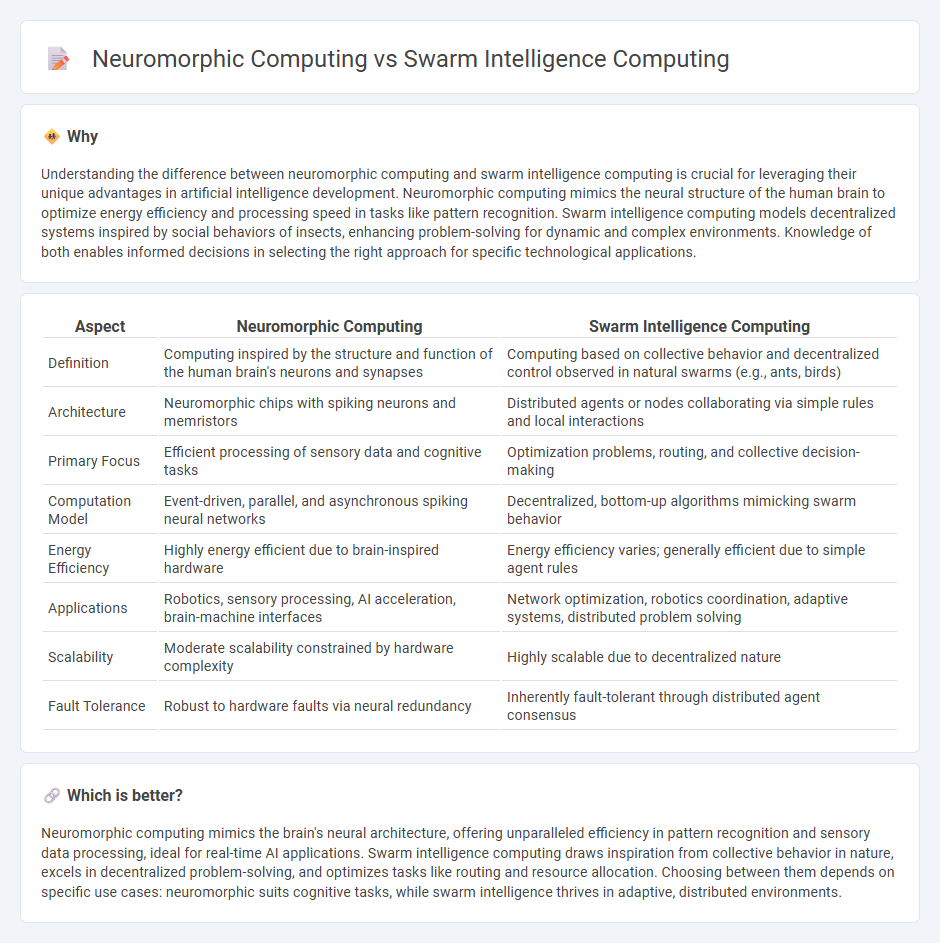
Neuromorphic computing mimics the structure and function of the human brain using artificial neurons and synapses to achieve energy-efficient, parallel processing ideal for pattern recognition tasks. Swarm intelligence computing draws inspiration from the collective behavior of decentralized systems like ant colonies or bird flocks to solve complex optimization problems through simple agent interactions. Explore the advancements and applications that distinguish neuromorphic computing from swarm intelligence computing.
Why it is important
Understanding the difference between neuromorphic computing and swarm intelligence computing is crucial for leveraging their unique advantages in artificial intelligence development. Neuromorphic computing mimics the neural structure of the human brain to optimize energy efficiency and processing speed in tasks like pattern recognition. Swarm intelligence computing models decentralized systems inspired by social behaviors of insects, enhancing problem-solving for dynamic and complex environments. Knowledge of both enables informed decisions in selecting the right approach for specific technological applications.
Comparison Table
| Aspect | Neuromorphic Computing | Swarm Intelligence Computing |
|---|---|---|
| Definition | Computing inspired by the structure and function of the human brain's neurons and synapses | Computing based on collective behavior and decentralized control observed in natural swarms (e.g., ants, birds) |
| Architecture | Neuromorphic chips with spiking neurons and memristors | Distributed agents or nodes collaborating via simple rules and local interactions |
| Primary Focus | Efficient processing of sensory data and cognitive tasks | Optimization problems, routing, and collective decision-making |
| Computation Model | Event-driven, parallel, and asynchronous spiking neural networks | Decentralized, bottom-up algorithms mimicking swarm behavior |
| Energy Efficiency | Highly energy efficient due to brain-inspired hardware | Energy efficiency varies; generally efficient due to simple agent rules |
| Applications | Robotics, sensory processing, AI acceleration, brain-machine interfaces | Network optimization, robotics coordination, adaptive systems, distributed problem solving |
| Scalability | Moderate scalability constrained by hardware complexity | Highly scalable due to decentralized nature |
| Fault Tolerance | Robust to hardware faults via neural redundancy | Inherently fault-tolerant through distributed agent consensus |
Which is better?
Neuromorphic computing mimics the brain's neural architecture, offering unparalleled efficiency in pattern recognition and sensory data processing, ideal for real-time AI applications. Swarm intelligence computing draws inspiration from collective behavior in nature, excels in decentralized problem-solving, and optimizes tasks like routing and resource allocation. Choosing between them depends on specific use cases: neuromorphic suits cognitive tasks, while swarm intelligence thrives in adaptive, distributed environments.
Connection
Neuromorphic computing and swarm intelligence computing both draw inspiration from natural systems to enhance computational efficiency and adaptability. Neuromorphic computing mimics the neural architecture of the human brain to process information through artificial neurons and synapses, while swarm intelligence leverages decentralized, collective behavior observed in social insects like ants or bees to solve complex problems. Their connection lies in utilizing distributed, parallel processing and adaptive learning mechanisms to improve problem-solving in dynamic and uncertain environments.
Key Terms
**Swarm Intelligence Computing:**
Swarm intelligence computing leverages decentralized, collective behavior inspired by social insects like ants and bees to solve complex optimization and coordination problems efficiently. It enables scalable, adaptive systems that excel in dynamic environments by utilizing simple agents interacting locally to produce emergent intelligent behavior. Discover more about how swarm intelligence computing revolutionizes problem-solving in AI and robotics.
Decentralization
Swarm intelligence computing leverages decentralized agents to collaboratively solve complex problems through local interactions without centralized control, mimicking behaviors observed in social insects. Neuromorphic computing, inspired by the brain's neural architecture, distributes processing across interconnected neurons to achieve parallelism and fault tolerance, promoting massive decentralization in data processing. Explore further to understand how these paradigms revolutionize decentralized computing architectures.
Agent-based models
Swarm intelligence computing employs agent-based models inspired by collective behavior in social insects, where simple agents follow local rules to achieve complex problem-solving without centralized control. Neuromorphic computing, on the other hand, mimics the neural architecture of the human brain using spiking neural networks designed to process information with low power consumption and high efficiency. Explore how these paradigms differ in scalability, adaptability, and computational frameworks to optimize agent-based solutions in artificial intelligence.
Source and External Links
What are the key principles of swarm intelligence? - This article discusses the core principles of swarm intelligence, including decentralized control and self-organization, inspired by natural collective behaviors.
Swarm Intelligence in Data Science: Applications, Opportunities and Challenges - This article explores swarm intelligence in data science, focusing on its applications and opportunities in optimization and searching techniques.
Swarm Intelligence: Definition, Explanation, and Use Cases - This article provides a comprehensive overview of swarm intelligence, including its definition, algorithms like ACO and PSO, and use cases in AI.
 dowidth.com
dowidth.com